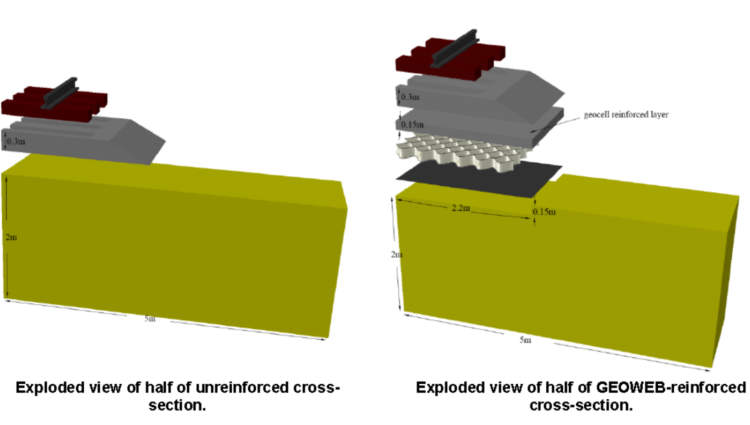
Railways allocate a significant amount of capital and maintenance costs to maintaining high-quality ballast layers, which are critical to a successful rail operation.
With ballooning rail traffic carrying heavier loads than ever, GEOWEB cellular confinement (Geocell) effectively takes the pressure off critical ballast systems.
Oregon State University (OSU) recently performed state-of-the-art, three-dimensional dynamic Finite Element modelling to analyse the reinforcing benefit of GEOWEB geocells in railway applications.
This study was completed in cooperation with the University of Kansas (KU) who simultaneously performed a testing program of Geocell reinforced ballast placed over weak subgrade material using HDPE GEOWEB material.
The digital modelling results were reinforced by the laboratory tests and showed a significant decrease in settlement of the railway ballast when GEOWEB confinement was used.
The use of GEOWEB technology not only decreased settlement, but reduced pressure on point-to-point aggregate load transfer contact which in turn resulted in less damage to ballast aggregate particles leading to less progressive deformation and longer maintenance frequencies of the entire ballast embankment. In short, more cycles means less track downtime for maintenance.
The research results were clear. The benefits of applying GEOWEB Geocell confinement for reinforcement of real ballast over weak subgrades includes:
- Significant decrease in settlement of the railway ballast. GEOWEB confinement influence reduced settlement by to up 50% under heavy freight loadings over weak subgrades.
- Decrease in subgrade interface pressure by nearly 50% for weak subgrades. The decreased pressure in subgrade results in lower subgrade settlements.
- Increase in ballast resiliency after many cycles, resulting in decreased rate of cyclic settlement.
- Decrease in lateral heave and movement of the ballast material.
- Redistribution of vertical stresses on the subgrade, resulting in higher shear strength and reduction in plastic deformation.
- For the largest loading conditions used in the analysis, the strains in the GEOWEB geocell were low (less than 1%) and within the elastic range for typical geosynthetic materials. The maximum tensile strains were localised at the bottom corners of the GEOWEB cells, illustrating the importance of adequately durable seams.
- Strains in the GEOWEB ballast layer were low (less than 1%) even under heavy, freight loadings over very soft subgrades. Stress concentrations were found at the seams, highlighting the importance of GEOWEB seam strength during loading condition.
A better-built ballast
The benefits of GEOWEB confined ballast are substantiated through rigorous testing. Conventional ballast reinforcing materials, such as geogrids, Hot Mix Asphalt (HMA), do not have the strengthening attributes that GEOWEB geocells can provide, especially in soft subgrades.
Building a more stable ballast layer with less settlement, higher shear strength, and less maintenance requirements is possible when built with GEOWEB geocells.

